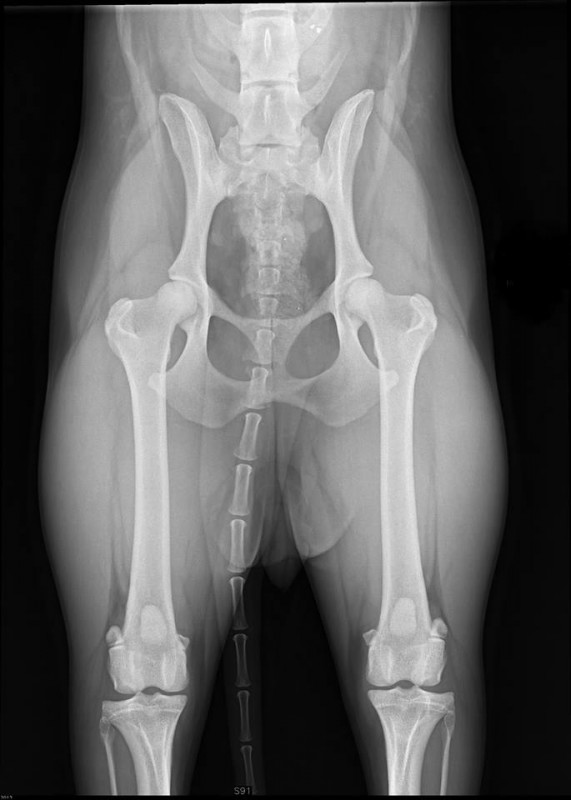Health
What ABOUT THE HEALTH of the Stabijhoun?
The Stabijhoun is, despite its small population, fortunately a relatively healthy breed. NVSW does everything possible to keep it that way. Nevertheless, we see certain diseases more or less occurring regularly. The breeding program of our association is aimed to reduce these occurrences as much as possible. It is not easy, because the causes are not always clear or strictly hereditary. It would be unwise to exclude too many dogs from our breeding program, because then we would lose genetic material. Too few dogs inevitably results in a higher inbreeding percentage, which can lead to more genetic health problems and eventually extinction. So there is a definite challenge in making smart matches!
Below are the problems that are known to the Stabijhoun breed along with how often (or how little) they occur in the population, and how we attempt to deal with it in our breeding program.
 Hip dysplasia (HD)
Hip dysplasia (HD)
Hip dysplasia is a developmental disorder of the hip joints caused by both genetic factors and environmental factors. Symptoms include difficulty getting up and lameness in the hindquarters. HD can be determined by making radiographs of the hip joints. An HD-A (Excellent or Good) result is the best, HD-E (Severe) the worst.
How often does it occur: about 3 to 4 times a year radiographic HD D in a Staby is clinically observed in Holland, however, these are rarely formally reported. Only a very few times lameness is seen that an operation was necessary. HD-E has only been recorded once in Holland over the past 10 years.
The breeding regulation of the NVSW: HD radiographs are required. Results of A and B (Excellent, Good or Fair) may be bred with dogs receiving the equivalent ratings.
Elbow dysplasia (ED)
Elbow dysplasia is a collective name for the three types of developmental elbow joints caused by both genetic and environmental factors. Sufferers exhibit lameness in the front legs. ED sufferers can be determined by x-ray, while carriers cannot.
How often does it occur: On average in recent years, ED is reported in a Staby 3 to 4 times a year, often recognized by a lame walk; dogs often then need surgery. There is a good prognosis if intervened in time.
The breeding regulation of the NVSW: Proven sufferers and carriers should not be bred (a proven carrier is a dog that has passed the same condition in 2 different litters). Immediate family of a sufferer not be combined with dogs that also have sufferers in their direct family lineage.
Epilepsy
In epilepsy, a fault in the brain suddenly occurs, and the dog loses control over a part of his body: he falls down and gets violent muscle spasms, foaming at the mouth can occur and he can lose control over his urine or feces. However, there are also milder forms of expression. Epilepsy can be hereditary but also can be caused by environmental factors. The hereditary form reveals itself in the Staby usually around two years of age.
How often does this occur: on average, four cases per year are seen in Holland. Before the breeding regulation was established here, epilepsy was more common.
The breeding regulation of the NVSW: preventive research on carriers is not possible. Proven sufferers and carriers should not be bred (a proven carrier is a dog who has passed that same condition in 2 different litters). Immediate family of a sufferer cannot be combined with dogs that also have sufferers in their direct family lineage.
Patent ductus arteriosus (PDA)
This is a heart condition. The veterinarian can hear this condition on the left side of the heart at the age of 6 to 7 weeks. It sounds like a loud engine noise. The cause is that a major blood vessel does not properly close shortly after birth. The occurrence may be spontaneous and an isolated case, but it is also genetically determined. If not treated, the patient eventually dies from heart failure. With timely surgery, the prognosis is excellent.
How common is it: PDA is found in 2 to 3 litters a year in Holland although that number seems to be somewhat on the rise. There is additional extensive investigation being done in collaboration with the University of Utrecht.
The breeding regulation of the NVSW: preventive research on carriers is not possible. Proven sufferers and carriers should not be bred (a proven carrier is a dog who has passed that same condition in 2 different litters). Immediate family of a sufferer cannot be combined with dogs that also have sufferers in their direct family lineage.
Neurological disorder
This is a relatively rare problem, for which the markers have been discovered through research at the University of Utrecht. Around 6 weeks of age, puppies exhibit a compulsive deviant behavior: always repeating the same movement; circling, reversing direction, or walking back and forth. Sufferers have an excessive urge to move, eat poorly, becoming emaciated and dying within a few months.
How common is it: So far, it has been detected in only six litters in the last four years.
The breeding regulation of the NVSW: Since April 2015, the DNA sequence for this disorder is known. Every dog used for breeding must be tested. Carriers can not be combined.
VWD, Type I (VWD)
VWD is a bleeding disorder that occurs in 3 types. The Type I, the mildest form, has been detected in the Stabij. Here there is a reduced production of a specific coagulation factor causing dogs to bleed for an extended time. Owners often do not notice this with their dog. Carriers have little to no risk, but sufferers can have problems if severely wounded or run into problems during surgery. There is a DNA test available to sufferers, and carriers can be identified.
How common is it: roughly a quarter of the Stabij population is free of VWD, half are carriers and a quarter are sufferers. Clinical symptoms are rarely reported.
The breeding regulation of the NVSW: there is no breeding policy for VWD; the DNA test is not required as there have been no reported problems, even with the sufferers. Read more detailed information about Von Willebrands Disease.
Note:
Other health problems are sporadically reported which cannot always be determined whether they are isolated cases or genetic. These dogs should not be bred in any case. A breeder, who wants to cross lines where the same problem exists on both sides of the pedigree, will get a negative advice for the breeding combination.

